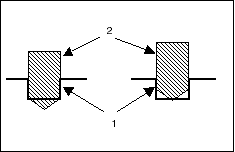The Drilling Strategy Dialog Box
The Holemaking Method section of the Drilling Strategy dialog box contains the following options.
Cycle Type
• Drill—Drill a hole. Depending on the Cycle Modifier option selected, the following statement will be output to the NC file:
◦ Standard—CYCLE / DRILL
◦ Deep—CYCLE / DEEP
◦ Break Chip—CYCLE / BRKCHP
◦ Web—CYCLE / THRU (for multiple plates)
• Tap—Drill a threaded hole. Expert Machinist supports ISO standard thread output. The CYCLE / TAP statement will be output to the NC file.
• Ream—Create a precision finish hole. The CYCLE / REAM statement will be output to the NC file.
• Bore—Bore a hole to create a finish hole diameter with high precision. The CYCLE / BORE statement will be output to the NC file.
• Spotface—Drill a hole with an optional dwell at final depth to help assure a clean surface at the bottom of the hole. The CYCLE / FACE statement will be output to the NC file.
• Countersink—Drill a chamfer for a countersunk screw. The CYCLE / CSINK statement will be output to the NC file. Select one of the Cycle Modifier options:
◦ Countersink—Type the desired diameter value in the Countersink text box. Countersink diameter is the final diameter of the hole after drilling, measured at the top of the chamfer. Tool parameter Point Angle defines the chamfer angle.
◦ Edge Break—Type the desired value in the Edge Break text box. Tool parameter Point Angle defines the chamfer angle.
◦ Auto Chamfer—When you select this option, the system automatically finds all the chamfers with the angle matching the Point Angle of the current tool, and makes the necessary calculations for drilling based on the chamfer geometry.
Cycle Depth
These options define the depth of drilling:
• Auto—Depth of drilling is determined automatically, by referencing hole geometry. If the selected axis is associated with several coaxial hole features, the maximum depth will be selected as long as the tool fits inside the hole diameter, as shown in the illustration below.

• Thru All—Drill a through hole, all the way through the stock. If you specify a breakout distance for Through drilling on the Cut Control tab of the Drilling Properties dialog box, the system adds this value when calculating depth.
• Constant—Drill to specified depth. Type the drill depth value in the textbox below.
Measured Depth
These options define how the depth of drilling is measured with respect to the tool:
• Tool Shoulder—The drilling depth is measured with reference to the shoulder of the tool.
• Tool Tip—The drilling depth is measured with reference to the tip of the tool.
In the following illustration, the picture on the left shows drilling using Tool Shoulder, and the picture on the right shows drilling using Tool Tip. In both pictures, 1 indicates the outline of the hole being drilled and 2 indicates the outline of the tool at the final drilling depth.

Offset Value—Type the tool offset value.
Register—Type the tool offset register number.
Hole Order
These options define the order of machining the holes:
• Shortest—The system determines which order of holes results in the shortest machine motion time.
• One Direction—The system scans the holes with respect to the Program Zero coordinate system, by incrementing the X coordinate and decrementing the Y. In the following illustration, this scan type is shown in the left picture.
• Back & Forth—The system scans the holes with respect to the Program Zero coordinate system, by incrementing the Y coordinate and going back and forth in the X direction. In the following illustration, this scan type is shown in the middle picture.
• Spiral—The system scans the holes clockwise starting from the hole nearest to the Program Zero coordinate system. In the following illustration, this scan type is shown in the right picture.

Start Hole—Lets you select the first hole to be machined if the Hole Order option is Shortest or Spiral.
The Drilling Properties button opens the Drilling Properties dialog box, which provides access to lower-level control of the tool path, such as spindle and coolant statements, speeds, feeds, clearances, entry/exit, and cut control options. The Cut Control tab contains options for adjusting hole depth:
• Through Holes—Select this option to adjust the depth for through holes. Type the adjustment value in the text box to the right.
• Blind Holes—Select this option to adjust the depth for blind holes. Type the adjustment value in the text box to the right.
The Options section of the Drilling Strategy dialog box contains the following option:
Use Fixture Offset—Allows you to store the fixture transformation offset in a register on your machine. Type the Fixture Offset register value in the text box to the right. If you use this option, NC output will contain the SET/OFSETL statements.